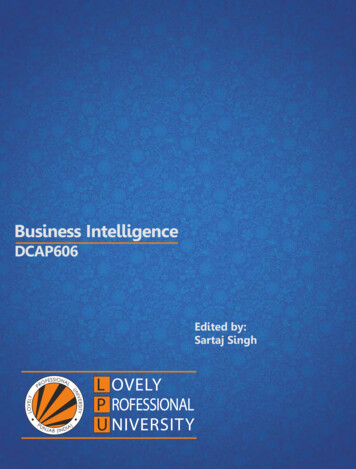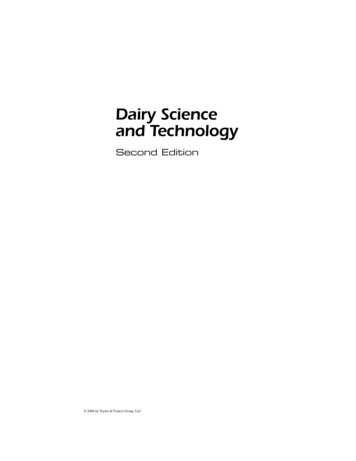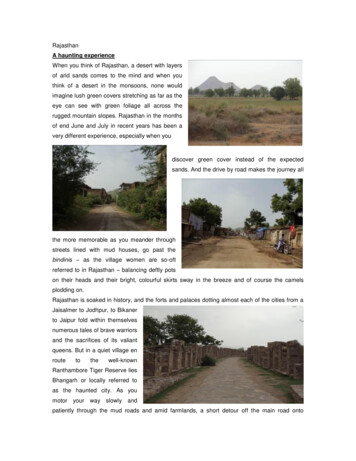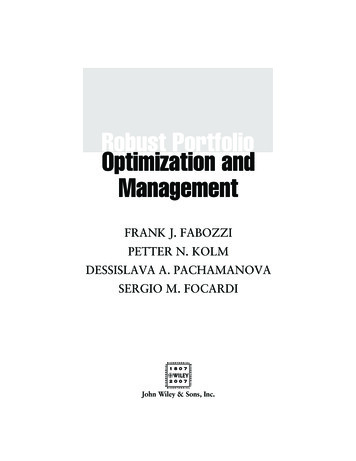
Transcription
- " Edited by:Sartaj Singh
www.lpude.inDIRECTORATE OF DISTANCE EDUCATIONBUSINESS INTELLIGENCEEdited BySartaj Singh
Printed byEXCEL BOOKS PRIVATE LIMITEDA-45, Naraina, Phase-I,New Delhi-110028forLovely Professional UniversityPhagwara
CONTENTUnit 1:Introduction to Business Intelligence1Sartaj Singh, Lovely Professional UniversityUnit 2:Multidimensional Analysis14Sartaj Singh, Lovely Professional UniversityUnit 3:Dimensional Data Warehouse28Sartaj Singh, Lovely Professional UniversityUnit 4:Understanding OLAP43Sartaj Singh, Lovely Professional UniversityUnit 5:Microsoft Business Intelligence Platform59Deepak Mehta,Lovely Professional UniversityUnit 6:Business Intelligence Project83Deepak Mehta, Lovely Professional UniversityUnit 7:Creating Cube102Deepak Mehta, , Lovely Professional UniversityUnit 8;Advanced Measures and Calculations115Deepak Mehta, Lovely Professional UniversityUnit 9:Advanced Dimensional Design128Deepak Mehta, Lovely Professional UniversityUnit 10:Retrieving Data from Analysis Services141Sartaj Singh, Lovely Professional UniversityUnit 11:Data Mining150Sartaj Singh, Lovely Professional UniversityUnit 12:Understanding Data Mining Tools166Sartaj Singh, Lovely Professional UniversityUnit 13:Creating Data Mining Queries and Reports178Sarabjit Kumar, Lovely Professional UniversityUnit 14:Reporting ToolsSartaj Singh, Lovely Professional University189
SYLLABUSBusiness IntelligenceObjectives: To impart the skills needed to manage database of large scale organization, techniques for data mining. Studentwill learn OLAP and generating quick reports.S. No.Description1.Business Intelligence: Introduction, Meaning, Purpose and Structure of Business Intelligence Systems.Understanding Multidimensional Analysis Concepts: Attributes, Hierarchies and Dimensions in dataAnalysis. Understanding Dimensional Data Warehouse: Fact Table, Dimension Tables, Surrogate Keys andalternative Table Structure. What is multi-dimension OLAP?2.Understanding OLAP: Fast response, Meta-data based queries, Spread sheet formulas. UnderstandingAnalysis Services speed and meta-data. Microsoft’s Business intelligence Platform. Analysis Services Tools.Data Extraction, Transformation and Load. Meaning and Tools for the same.3.Creating your First Business Intelligence Project: Creating Data source, Creating Data view. Modifying theData view. Creating Dimensions, Time, and Modifying dimensions. Parent-Child Dimension.4.Creating Cube: Wizard to Create Cube. Preview of Cube. Adding measure and measure groups to a cube.Calculated members. Deploying and Browsing a Cube.5.Advanced Measures and Calculations: Aggregate Functions. Using MDX to retrieve values from cube.Calculation Scripting. Creation of KPI’s.6.Advanced Dimensional Design: Creating reference, fact and many to many dimensions. Using FinancialAnalysis Cubes. Interacting with a cube. Creating Standard and Drill Down Actions.7.Retrieving Data from Analysis Services: Creating Perspectives, MDX Queries, Excel with Analysis Services.8.Data Mining: Meaning and purpose. Creating data for data mining. Data mining model creation. Selectingdata mining algorithm. Understanding data mining tools. Mapping Mining Structure to Source Data columns.Using Cube Sources. Configuring Algorithm parameters.9.Creating Data mining queries and reports: Creation of Prediction queries. Understanding DMX language.10.Reporting Tools: Using SQL Server Reporting Services to develop reports for analysis services.
Sartaj Singh, Lovely Professional UniversityUnit 1: Introduction to Business IntelligenceUnit 1: Introduction to Business Meaning of Business Intelligence1.2History of Business Intelligence1.2.1The Data Warehouse1.2.2Offline Extract, Transform and Load (ETL)1.2.3Data-Mining Engines1.2.4Reporting Tools1.2.5Data Marts1.3Purpose of Business Intelligence Systems1.4Structure of Intelligence Systems1.4.1Business Intelligence Applications1.4.2Decision Support Tools1.4.3Access Enablers1.4.4Data Management1.4.5Data Warehouse Modelling1.5Summary1.6Keywords1.7Review Questions1.8Further ReadingsObjectivesAfter studying this unit, you will be able to: Discuss the meaning of Business Intelligence Explore history of Business Intelligence State the purpose of Business Intelligence Systems Construct structure of Intelligence SystemsIntroductionBusiness Intelligence (BI) is a set of ideas, methodologies, processes, architectures, andtechnologies that change raw data into significant and useful data for business purpose. BusinessIntelligence can handle large amounts of data to help identify and evolve new opportunities forthe business. Making use of these new opportunities and applying a productive scheme on it canprovide a comparable market benefit and long-term stability.LOVELY PROFESSIONAL UNIVERSITY1
Business IntelligenceNotesBusiness Intelligence (BI) technologies provide chronicled, present and predictive view of businessoperations. Common functions of enterprise Intelligence technologies are reporting, onlineanalytical processing, analytics, data excavation, process excavation, business performancemanagement, benchmarking, text mining, predictive analytics and prescriptive analytics.1.1 Meaning of Business IntelligenceBI (Business Intelligence) refers to set of techniques which assist in spotting, digging out andinvestigating best data from the large amount of data to improve conclusion making. Let usunderstand the concept better with help of an example.Example: Suppose we have chronicled data of a Shopping Mart of 3-6 months. Here, inthe data we have different products with their respective specifications. Let us select one of theproducts-say Candles. We have three kinds of Candles in this class say Candle A, Candle B,Candle C. On studying of these data we come to know that sale of Candle C was at peak out ofthese three classes. Now on afresh and deep study into these data we got the outcome that thesale of this Candle C was maximum between the time intervals of 9 am to 11 am. On furtherdeeper analysis, we came to the conclusion that this specific Candle is the one used in place ofworship.Now, let’s apply Business Intelligence for this analysis. What an enterprise firm or the organizationcan do is, get other material that can be used in church and place them nearby those candles.Now the customers approaching the Shopping Mart to purchase the candles for place of worshipcan also have a look on the other material and may be tempted to purchase them as well. Nowthis will surely enhance the sales and hence the income of Shopping Mart.Self AssessmentFill in the blanks:1. can handle large amounts of data to help identify and evolve newopportunities for the business.2.BI (Business Intelligence) refers to set of techniques which assist in ., diggingout and . best data from the large amount of data to improve conclusionmaking.1.2 History of Business IntelligenceNormally, early business applications had their own databases that supported their functions.These databases became “islands of information” in that no other systems had access to them.These islands of information proliferated as more and more departments were automated.Did u know? Amalgamations and acquisitions aggregated the difficulty since the companiesintegrated completely distinct systems, numerous of which were doing the similar job.However, businesses shortly identified the analytical value of the data that they had access to.In fact, as enterprises automated more systems, more data became accessible. However, collectingthese data for analysis was a challenge because of the incompatibilities amidst systems.2LOVELY PROFESSIONAL UNIVERSITY
Unit 1: Introduction to Business IntelligenceNotes!Caution There was no simple way (and often no way) for these systems to interact.An infrastructure was required for data exchange, collection, and analysis that could supply aunified view of an enterprise’s data. The data warehouse evolved to complete this need.1.2.1 The Data WarehouseThe concept of the data warehouse (Figure 1.1) is a lone scheme that is the repository of all of theorganization’s data (or simply data) in a pattern that can be competently analysed so thatsignificant accounts can be arranged for administration and other information workers.Figure 1.1: Data Warehouse ConceptPoint of SaleGift RegistryInventoryAd HocQueriesETL BatchtransfersReportsData WarehousedashboardsSales Promotions Source: arehouse.pngHowever, meeting this goal requires some challenges: Data should be acquired from a variety of incompatible systems. The identical piece of data might reside in the databases of distinct systems in distincttypes. A specific data item might not only be represented in distinct formats, but thevalues of this Data piece might be distinct in distinct databases. Which value is the correctone? Data is continually altering. How often should the Data warehouse be revised tocontemplate a sensibly current view? The amount of Data is massive. How is it analysed and presented easily so that it is useful?To meet these needs, a broad range of powerful tools were developed over the years and becameproductized. They included: Extract, Transform, and Load (ETL) utilities for the moving of data from the diverse datasources to the common data warehouse. Data-mining pushes for complex predetermined analysis and ad hoc queries of the Dataretained in the Data warehouse. Reporting tools to provide management employees with the outcomes of the analysis invery simple to absorb formats.LOVELY PROFESSIONAL UNIVERSITY3
Business IntelligenceNotes1.2.2 Offline Extract, Transform and Load (ETL)Early on, the one common interface that was provided between the disparate systems in anassociation was magnetic tape. Tape formats were standardized, and any system could composetapes that could be read by other systems. Thus, the first data warehouses were fed by magnetictapes prepared by the various systems inside the association. However, that left the difficulty ofdata disparity. The data written by the different systems reflected their native data associations.Notes The data written to tape by one system often had little relation to the similar datawritten by another system.Even more important was that the data warehouse’s database was designed to support theanalytical functions needed for the business intelligence function. This database design wastypically a highly organised database with complex indices to support Online AnalyticalProcessing (OLAP). Databases configured for OLAP allowed complex analytical and ad hocqueries with rapid execution time. The data fed to the data warehouse from the enterprisesystems was converted to a format significant to the data warehouse.To explain the difficulty of initially stacking this data into a data warehouse, holding it updated,and resolving discrepancies, Extract, Transform and Load (ETL) utilities were evolved. As theirname suggests, these utilities extract data from source databases, change/transform them intothe widespread data warehouse format, and load them into the data warehouse, as shown inFigure 1.2.Figure 1.2: Extract/Transform/Load StructureETL – Extract/Transofrm/LoadSource: ngThe transform function is the key to the achievement of this approach. Its job is to request aseries of rules to extracted data so that it is properly formatted for loading into the data warehouse.An example of transformation rules includes:4 The selection of data to load. The translation of encoded items (for example, 1 for male, 2 for female to M, F).LOVELY PROFESSIONAL UNIVERSITY
Unit 1: Introduction to Business Intelligence Deriving new calculated values (sale price price - discount). Merging data from multiple sources. Summarizing (aggregating) certain rows and columns. Splitting a column into multiple columns. Resolving discrepancies between similar data items. Validating the data.NotesFigure 1.3 Shows Representation of ETL ModelFigure 1.3: Representation of ETL ModelSource: http://3.bp.blogspot.com/ 600/ETL Global.jpgThe ETL function permits the consolidation of multiple data sources into a well-structureddatabase for use in complex analysis. The ETL process is performed occasionally, such as daily,weekly, or monthly, depending upon the enterprise needs. This method is called offline ETLbecause the key database is not relentlessly updated. It is revised on a periodic batch basis.Though offline ETL serves its purpose well, it has some drawbacks as well: The data in the data warehouse is not fresh. It could be weeks old. Though, it is useful forstrategic functions but is not especially adaptable to tactical use. The source database typically should be temporary inactive throughout the extract method.Otherwise, the target database is in an inconsistent state following the load. With thisresult, the applications must be shutdown, often for hours.In order to develop to support real-time business intelligence, the ETL function must be relentlessand non-invasive, which is called online ETL, and is recounted later. In compare to offline ETL,which supplies data which is not fresh but reliable answers to queries, online ETL suppliespresent but varying answers to successive queries since the data that it is using is constantlybeing updated to reflect the current state of the business.LOVELY PROFESSIONAL UNIVERSITY5
Business IntelligenceNotes1.2.3 Data-Mining EnginesThe ETL utilities make data collection from numerous diverse systems practical. Then, the dataneeds to be converted into useful information. Some key points to remember: Data are easily facts, figures, and text that can be processed by a computer.Example: A transaction at retail point-of-sale is data. Information is processed data. For example, analysis of point-of-sale transactions yieldsinformation of consumer buying behaviour. Knowledge represents a pattern that connects information and usually presents a highgrade of predictability as to what is recounted or what will happen next.Example: An example of knowledge is the prediction of promotional efforts on sales ofparticular items based on buyers’ buying behaviour.Useful data-mining engines were evolved to support complex analysis and ad hoc queries on adata warehouse’s database. Data mining looks for patterns among hundreds of seeminglyunrelated fields in a large database, patterns that recognize earlier unknown trends. Thesetrends play a key role in strategic decision making because they disclose localities for processenhancement.Example: Data-mining engines are those from SPSS and Oracle which are the foundationfor OLAP (Online Analytical Processing) systems.1.2.4 Reporting ToolsThe knowledge created by a data-mining engine is not very useful unless it is presented easilyand clearly to those who need it. There are many formats for reporting information andknowledge results. One of the common techniques for displaying information is the digitaldashboard (shown in Figure 1.4).Figure 1.4: Digital dashboardSource: http://www.powerhealthsolutions.com/images/PBR DigitalDashboard KPIs.png6LOVELY PROFESSIONAL UNIVERSITY
Unit 1: Introduction to Business IntelligenceIt provides a business manager with the input necessary to push the business towards success.It presents the client a graphical view of business processes. The client then drills down the dataat will to get more details on a specific process. Today, many versions of digital dashboards areaccessible from a kind of software vendors.Notes1.2.5 Data MartsAs corporate-wide data warehouses came into use, it was discovered that in many situations afull-blown data warehouse was overkill for applications. Data marts evolved to solve thisproblem. A data mart is a special type of a data warehouse. It is focused on a single subject (orfunctional area), such as Sales, Finance, or Marketing. Whereas data warehouses have an enterprisewide depth, the information in data marts pertains to a single department. The primary use fora data mart is Business Intelligence (BI) applications. Implementing a data mart can be lessexpensive than implementing a data warehouse, thus making it more practical for the smallbusiness.Notes A data mart can also be set up in much less time than a data warehouse.Figure 1.5 shows the relationship between data warehouse and data mart.Figure 1.5: Relationship between Data Warehouse and Data MartSource: ESTO%20v2 0/data%20mart%20%20top%20down.pngSelf AssessmentFill in the blanks:3.An . was required for data exchange, collection, and analysis that couldsupply a unified view of an enterprise’s data.4. utilities for the moving of data from the diverse data sources to thecommon data warehouse.5.The first data warehouses were fed by . prepared by the various systemsinside the association.LOVELY PROFESSIONAL UNIVERSITY7
Business IntelligenceNotes6.The data fed to the data warehouse from the . was converted to a formatsignificant to the data warehouse.7.The job of . is to request a series of rules to extracted data so thatit is properly formatted for loading into the data warehouse.8.The . function permits the consolidation of multiple data sources into awell-structured database for use in complex analysis.9.In compare to offline ETL, . supplies present but varying answers tosuccessive queries.10. represents a pattern that connects information and usually presents ahigh grade of predictability as to what is recounted or what will happen next.11.A . is a special type of a data warehouse focused on a single subject (orfunctional area), such as Sales, Finance, or Marketing.12.The primary use for a data mart is . applications.1.3 Purpose of Business Intelligence Systems‘The purpose of business intelligence systems is to utilise all your underlying business data tohelp executives make better business decisions,’ said Tony Banham, technology and solutionsdirector for Oracle Greater China.Business Intelligence process consists of 3 distinct tasks:1.The first task BI has to do is to gather the necessary data about the business. The key to thisis automating the process. Gathering data was very time and money consuming in thepast, but todays with the usage of modern computers, it’s much easier to collect data fromvarious sources.2.The second task is to analyse the collected data and then further extract information fromit. The extracted information is then transformed into knowledge.3.The final task is to use the newly gathered knowledge to improve the business.There are many business intelligence tools to complete the process of gathering knowledgerelated to business like Cognos, BizTools, Hummingbird and Informatica.1.4 Structure of Intelligence SystemsA business intelligence system has three key advantages:1.It not only supports the latest information technologies, but also provides pre-packagedapplication solutions.2.It focuses on the access and delivery of business information to end users, and supportboth information providers and information consumers.3.It support access to all forms of business information, and not just the information storedin a data warehouse.Figure 1.6 gives an overview of Structure of Business Intelligent System.1.4.1 Business Intelligence ApplicationsBusiness intelligence applications provide integrated business applications, hardware, software,and consulting services. Decision Edge from IBM, for example, analyses customer informationand based on that assists in the creation of tailored customer marketing programs.8LOVELY PROFESSIONAL UNIVERSITY
Unit 1: Introduction to Business IntelligenceFigure 1.6: IBM Business Intelligence Product SetNotesSource: .2 Decision Support ToolsQuery and ReportingThe two main query and reporting products (in IBM) are the Query Management Facility (QMF)and Lotus approach. QMF has been used for many years as a host-based query and reporting toolby DB2 whereas Lotus approach is a desktop relational DBMS that has gained popularity due toits easy-to-use query and reporting capabilities.Online Analytical Processing (OLAP)If we talk about IBM structure, its key product in the OLAP marketplace is the DB2 OLAP Server,which implements three-tier client/server architecture for performing complex data analysis.The value of the DB2 OLAP server lies in its ability to generate and manage relational tables thatcontain multidimensional data.Information MiningIntelligent Miner by IBM is one of the few products in the market to support an external API,allowing resultant data to be collected by other products (for example an OLAP product) forfurther analysis.LOVELY PROFESSIONAL UNIVERSITY9
Business IntelligenceNotes1.4.3 Access EnablersClient access to warehouse and operational data from business intelligence tools requires aclient database API.1.4.4 Data ManagementData management offers intelligent data partitioning and parallel query and utility processingof the data.Example: DB2 for OS/390, DB2 for VM, and DB2 for VSE DB2 Universal Database.1.4.5 Data Warehouse ModellingUsing Visual Warehouse a data warehouse can be designed and constructed. Tools for developingdata warehouse includes components for defining the relationships between the source data andwarehouse information, transforming source data and managing warehouse maintenance.Task Find out the procedure to extract data from each individual database.Self AssessmentState whether the following statements are true or false:13.The first task BI has to do is to gather the necessary data about the business.14.Business intelligence system do not supports the latest information technologies.15.The value of the DB2 OLAP server lies in its ability to generate and manage relationaltables that contain multidimensional data. Case StudyBusiness Intelligence ManagementYou are working for a sporting goods retail company. Overall sales have beendeclining for the last three quarters and management is very much concerned.Each retail store has its own individual databases that keep track of sales forspecific items. However at the overall management level, only sales figures for each storeare reported. Management has asked you to prepare reports by sale items (such as specificbrand X and model Y of running shoes) and by categories of sale items (such as all runningshoes) so that they can make accurate decisions on which product lines to drop to reduceoverall inventory costs. As a BI specialist or as a part of a development team, you will needto develop a procedure to extract data from each individual database, reconcile data formatsand types, aggregate all data into a data repository, and develop queries based onmanagement requests. You will communicate and work closely with managementrepresentatives to ensure that the created data repository and reports meet their needs.This usually involves a series of back and forth discussion during which both sides ask andanswer questions. You have to develop a good understanding of the business concernsContd.10LOVELY PROFESSIONAL UNIVERSITY
Unit 1: Introduction to Business Intelligenceand be able to frame them into technical requirements for the BI project. You also need toeducate management regarding possibilities and constraints of the technology as ittranslates into business applications. Depending on your level of responsibilities, youwill develop or contribute to the development of a realistic estimate of time, resourcesand cost to achieve the intended goal. Once the project is launched, you will develop fullspecifications, develop and test subsystems, and integrate into final product. Throughoutthe development process, you will conduct a series of increasingly rigorous technical,functional and user tests. Based on the results of these tests, you can expect revision oftechnical specifications, and overall system and unit design, along with project timeline,resources and cost revisions. Of particular importance will be a focus on user needs andrequirements, business applications, and easy-to-use user interface. Your BI team may bealso invoked in developing and delivering training to managers and other stakeholdersin using the new system.NotesQuestions:1.What are basic technical requirements for the BI project?2.Explain the procedure to extract data from each individual database.3.What role does BI specialist play in management company?4.What all factors will lead to reduction of the inventory cost?Source: 9d?overridelayout true&449296530374021.5 Summary Business Intelligence can handle large amounts of data to help identify and evolve newopportunities for the business. BI (Business Intelligence) refers to set of techniques which assist in spotting, digging outand investigating best data from the large amount of data to improve conclusion making. An infrastructure was required for data exchange, collection, and analysis that could supplya unified view of an enterprise’s data. Early on, the one common interface that was provided between the disparate systems inan association was magnetic tape. Databases configured for OLAP allowed complex analytical and ad hoc queries with rapidexecution time. The ETL function permits the consolidation of multiple data sources into a well-structureddatabase for use in complex analysis. In order to develop to support real-time business intelligence, the ETL function must berelentless and non-invasive, which is called online ETL, and is recounted later. The ETL utilities make data collection from numerous diverse systems practical. Useful data-mining engines were evolved to support complex analysis and ad hoc querieson a data warehouse’s database. There are many formats for reporting information and knowledge results. One of thecommon techniques for displaying information is the digital dashboard. Business intelligence applications provide integrated business applications, hardware,software, and consulting services.LOVELY PROFESSIONAL UNIVERSITY11
Business IntelligenceNotes1.6 KeywordsBusiness Intelligence (BI): Business Intelligence (BI) is a set of ideas, methodologies, processes,architectures, and technologies that change raw data into significant and useful data for businesspurpose.Business Intelligence Applications: Business intelligence applications provide integrated businessapplications, hardware, software, and consulting services.Data Marts: A data mart is the access layer of the data warehouse environment that is used to getdata out to the users.Data Warehouse: In computing, a data warehouse or enterprise data warehouse (DW, DWH, orEDW) is a database used for reporting and data analysis.Extract, Transform and Load (ETL): The process of extracting data from source systems andbringing it into the data warehouse is commonly called ETL.Magnetic Tape: Magnetic tape is a medium for magnetic recording, made of a thin magnetisablecoating on a long, narrow strip of plastic film.Online Analytical Processing (OLAP): OLAP is part of the broader category of businessintelligence, which also encompasses relational database, report writing and data mining.Query Management Facility (QMF): Query Management Facility is a query tool invented byIBM, for interfacing with their DB2 system. The most recent version is Version 9.2.1.7 Review Questions1.What is Business Intelligence (BI)?2.Define Business Intelligence. Give some examples.3.Briefly discuss history of Business Intelligent.4.Explain the concept of the data warehouse.5.What is offline Extract, Transform, and Load?6.What do you understand by data-mining engines?7.“Implementing a data mart can be less expensive than implementing a data warehouse”.Elucidate.8.What is the purpose of business intelligence systems?9.What are the key advantages of business intelligence system?10.Write the brief description of Business Intelligence Applications.Answers: Self Assessment121.Business Intelligence2.Spotting, investigating3.Infrastructure4.Extract, Transform, and Load (ETL)5.Magnetic tapes6.Enterprise systems7.Transform function8.ETL9.Online ETL10.KnowledgeLOVELY PROFESSIONAL UNIVERSITY
Unit 1: Introduction to Business Intelligence11.Data mart12.Business Intelligence (BI)13.True14.False15.TrueNotes1.8 Further ReadingsBooksCarlo Vercellis (2011). “Business Intelligence: Data Mining and Optimization for DecisionMaking”. John Wiley & Sons.David Loshin (2012). “Business Intelligence: The Savvy Manager’s Guide”. Newnes.Elizabeth Vitt, Michael Luckevich, Stacia Misner (2010). “Business Intelligence”.O’Reilly Media, Inc.Rajiv Sabhrwal, Irma Becerra-Fernandez (2010). “Business Intelligence”. JohnWiley & Sons.Swain Scheps (2013). “Business Intelligence for Dummies”. Wiley.Online .com/cd/B19306 LOVELY PROFESSIONAL UNIVERSITY13
Business IntelligenceSartaj Singh, Lovely Professional UniversityNotesUnit 2: Multidimensional AnalysisCONTENTSObjectivesIntroduction2.1Dimension Attributes2.1.12.2Key AttributeDimension Hierarchy2.2.1Type of Hierarchy2.3Summary2.4Keywords2.5Review Questions2
Objectives: To impart the skills needed to manage database of large scale organization, techniques for data mining. Student will learn OLAP and generating quick reports. S. No. Description 1. Business Intelligence: Introduction, Meaning, Purpose and Str










